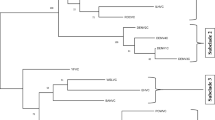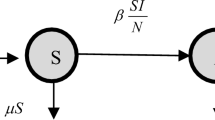Summary
The virus yields and number of infectious centres of HSV infected mouse neuroblastoma C1300 cells (clone 41 A3) infected at different multiplicities of infection (MOI) were found to vary more than the differences of HSV concentrations of the virus suspensions used for infection of the cells. This suggested that a C1300 cell had to be infected with more than one HSV particle in order to produce progeny virus—multiplicity activation. The greater than expected enhancement of virus production of C1300 cell cultures receiving increasing MOI of HSV was probably not due to improved virus adsorption, nor influenced by non-virus factors in the virus inoculum stimulatory for HSV replication. A hypothesis, that the block in virus replication was promoted by an inhibitor of an HSV specified regulatory protein and could be overcome by the addition of HSV DNA copies in the infected cell, was supported by the results of two types of experiments. Presence of phosphonoformic acid, an inhibitor of the HSV specified DNA polymerase, in the culture medium of HSV infected permissive GMK cells resulted in non-linear relationships between virus yields and MOI. An HSV temperature sensitive mutant (ts B5), defective in a late structural protein, rescued wild type HSV in C1300 cells.
Similar content being viewed by others
References
Adler, R., Glorioso, J. C., Levine, M.: Infection by herpes simplex virus and cells of nervous system origin: characterization of a nonpermissive interaction. J. gen. Virol.39, 9–20 (1978).
Aurelian, L., Roizman, B.: Abortive infection of canine cells by herpes simplex virus. II. Alternative suppression of synthesis of interferon and viral constituents. J. mol. Biol.11, 539–548 (1965).
Cook, M. L., Bastone, V. B., Stevens, J. G.: Evidence that neurons harbor latent herpes simplex virus. Infect. Immun.9, 946–951 (1974).
Dalton, D., Kim, K. S., Sharp, D. G.: Multiplicity activation of vaccinia virus in L Cells. Proc. Natl. Acad. Sci. U.S.A.58, 1758–1761 (1967).
Dulbecco, R., Vogt, M.: Plaque formation and isolation of pure lines with poliomyelitis viruses. J. exp. Med.99, 167–182 (1954).
Gerdes, J. G., Marsden, H. S., Cook, M. L., Stevens, J. G.: Acute infections of differentiated neuroblastoma cells by latency-positive and latency-negative herpes simplex virusts mutants. Virology94, 430–441 (1979).
Helgstrand, E., Eriksson, B., Johansson, N. G., Lannerö, B., Larsson, A., Misiorny, A., Norén, J. O., Sjöberg, B., Stenberg, K., Stening, G., Strid, S., Öberg, B., Alenius, S., Philipson, L.: Trisodium phosphonoformate, a new antiviral compound. Science201, 819–821 (1978).
Honess, R. W., Roizman, B.: Proteins specified by herpes simplex virus. XI. Identification and relative molar rates of synthesis of structural and non-structural herpesvirus polypeptides in the infected cell. J. Virol.12, 1347–1365 (1973).
Honess, R. W., Roizman, B.: Regulation of herpesvirus macromolecular synthesis. I. Cascade regulation of the synthesis of three groups of viral proteins. J. Virol.14, 8–19 (1974).
Kim, K. S., Sharp, D. G.: Rabbit pox virus. Anomalous plaque production. Virology30, 724–730 (1966).
Levine, M., Goldin, A. L., Glorioso, J. C.: Persistence of herpes simplex virus genes in cells of neuronal origin. J. Virol.35, 203–210 (1980).
Luria, S. E.: Reactivation of irradiated bacteriophage by transfer of self reproducing units. Proc. Natl. Acad. Sci. U.S.A.33, 253–264 (1947).
Manservigi, R., Spear, P. G., Buchan, A.: Cell fusion induced by herpes simplex virus is promoted and suppressed by different viral glycoproteins. Proc. Natl. Acad. Sci. U.S.A.74, 3913–3917 (1977).
McLennan, J. L., Darby, G.: Herpes simplex virus latency: the cellular location of virus in dorsal root ganglia and the fate of infected cell following virus activation. J. gen. Virol.51, 233–244 (1980).
Sharp, D. G.: Multiplicity reactivation of animal viruses. In:Melnick, J. L. (ed.), Progress in Medical Virology, Vol. 10, 64–109. Basel-New York: Karger 1968.
Stevens, J. G.: Latent herpes simplex virus and the nervous system. Curr. Top. Microbiol. Immunol.70, 31–50 (1975).
Svennerholm, B., Vahlne, A., Lycke, E.: Inhibition of herpes simplex virus infection in tissue culture by trisodium phosphonoformate. Proc. Soc. Exp. Med.161, 115–118 (1979).
Svennerholm, B., Vahlne, A., Jeansson, S., Lundén, R., Olofsson, S., Svantesson, G., Lycke, E.: Separation of herpes simplex virus virions and nucleocapsids on Percoll Gradients. J. virol. Meth.1, 303–309 (1980).
Vahlne, A., Blomberg, J., Olofsson, S., Lycke, E.: Subtyping of herpes simplex virus. Acta path. microbiol. scand. B83, 506–512 (1975).
Vahlne, A., Lycke, E.: Herpes simplex virus infection of mouse neuroblastoma cells. Proc. Soc. Exp. Biol. Med.156, 82–87 (1977).
Vahlne, A., Lycke, E.: Herpex simplex virus infection ofin vitro cultured neuronal cells (mouse neuroblastoma C 1300 cells). J. gen. Virol.39, 321–332 (1978).
Vahlne, A., Svennerholm, B., Lycke, E.: Studies on herpes simplex virus interaction with C 1300 cells. In: Abstracts of the Fourth International Congress for Virology, The Hague, 1978, 516. Wageningen: Pudoc 1978.
Vahlne, A., Nyström, B., Sandberg, M., Hamberger, A., Lycke, E.: Attachment of herpes simplex virus to neurons and glial cells. J. gen. Virol.40, 359–371 (1978).
Vahlne, A., Svennerholm, B., Sandberg, M., Hamberger, A., Lycke, E.: Differences in attachment between herpes simplex type 1 and type 2 viruses to neurons and glial cells. Infect. Immun.28, 675–680 (1980).
Author information
Authors and Affiliations
Additional information
With 4 Figures
Rights and permissions
About this article
Cite this article
Vahlne, A., Nilheden, E. & Svennerholm, B. Multiplicity activation of herpes simplex virus in mouse neuroblastoma (C1300) cells. Archives of Virology 70, 345–356 (1981). https://doi.org/10.1007/BF01320249
Received:
Accepted:
Issue Date:
DOI: https://doi.org/10.1007/BF01320249




